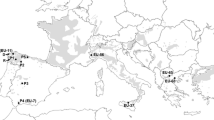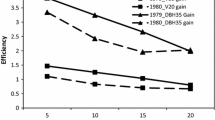Abstract
Blackwood (Acacia melanoxylon R.Br.) is a high-quality appearance-grade timber species native to eastern Australia. Wide variation in its survival, growth and form, together with issues related to site selection and intensive silvicultural management, limit progress in its domestication and commercial development. To determine the effect of genetics on these traits, five blackwood progeny trials in northern Tasmania, Australia, aged between 15 and 19 years were assessed. All trials contained a variety of open-pollinated, single-tree, family collections from Tasmania, with one trial containing a selection of provenances from mainland Australia. Significant genetic variation in survival, growth and form were found. This variation was partly explained by broad scale adaptive differences across the wide geographic distribution of blackwood. Blackwood from the tropical northern range of the species had poor survival in cool temperate Tasmania. Significant differences in survival between Tasmanian seedlots were also observed. Among the Tasmanian seedlots, those from low altitudes grew better than those from high altitudes, while those from the north-east of Tasmania had significantly better growth rates than seedlots from the south-east. Seedlots from the north-west seed zone had intermediate growth rates. Significant genetic differences in the proportion of trees with single stems, and the number of large branches in the lower stem were found between Tasmanian seedlots. Early-age seedlot height was significantly positively correlated with mid-age diameter. Stem form was improved under nurse crops, but even open-grown blackwood had low percentages of trees of excellent form. These results indicate that at the broad scale, climatic matching of seed source with planting site is clearly important, however, within Tasmania there was no evidence that seedlots collected from the same region as the trials outperformed those from other regions.



Similar content being viewed by others
References
Allen D (1992) Blackwood plantations in Tasmania. Tasmanian national rainforest conservation program report no. 8. Forestry Commission of Tasmania, Hobart
Appleton C, Walsh PJ, Wratten SD (1997) The influence of insect infestation on the growth of Tasmanian blackwood Acacia melanoxylon. NZ Entomol 20(1):73–77
Arnold R, Cuevas E (2003) Genetic variation in early growth, stem straightness and survival in Acacia crassicarpa, A. mangium and Eucalyptus urophylla in Bukidnon Province, Philippines. J Trop For Sci 15(2):332–351
Bey CF (1980) Growth gains from moving black walnut provenances northward. J For 78(10):640–645
Booth TH (1996) Matching trees and sites. In: Booth TH (ed). Proceedings of an international workshop held in Bangkok, Thailand, pp 27–30 March 1995. Australian Centre for International Agricultural Research, Canberra, Australia
Bootle KR (2005) Wood in Australia: types, properties and uses. McGraw Hill, Sydney
Bradbury GJ, Beadle CL (2007) Genetic resources in blackwood: a mini-review. In: Beadle CL, Brown AG (eds) Acacia utilisation and management: adding value. RIRDC Publication No. 07/095. Rural Industries Research and Development Corporation, Canberra, pp 101–107
Cowan RS, Maslin BR (2001) Acacia melanoxylon. Flora of Australia Online. Australian Biological Resources Study, Canberra. http://www.environment.gov.au/biodiversity/abrs/online-resources/flora/main/index.html Accessed 13 Mar 2008
Daehler CC, Yorkston M, Sun W et al (1999) Genetic variation in morphology and growth characters of Acacia koa in the Hawaiian Islands. Int J Plant Sci 160(4):767–773. doi:10.1086/314163
de Zwaan JG (1982) The silviculture of blackwood (Acacia melanoxylon). S Afr For J 121:38–43
de Zwaan J, van der Sijde H (1990) Early results of three blackwood (Acacia melanoxylon) provenance trials in South Africa. S Afr For J 152:23–25
Farrell TP, Ashton DH (1978) Population studies on Acacia melanoxylon R.Br. I. variation in seed and vegetative characteristics. Aust J Bot 26(3):365–379. doi:10.1071/BT9780365
Franklin D (1987) Resistance of Tasmanian blackwood to frost damage. NZ Tree Grower 18(3):74–75
Gilmour AR, Gogel BJ, Cullis BR, et al (2006) ASReml user guide release 2.0. VSN International Ltd, Hemel Hempstead, HP1 1ES, UK
Hai PH, Jansson G, Harwood C et al (2008) Genetic variation in growth, stem straightness and branch thickness in clonal trials of Acacia auriculiformis at three contrasting sites in Vietnam. For Ecol Manag 255(1):156–167
Jackson T, Bird R, Zollinger R (2004) Acacia melanoxylon provenance and layout research in south-western Victoria. In: Brown AG (ed) Blackwood management: learning from New Zealand. RIRDC Publication No. 04/086. Rural Industries Research and Development Corporation, Canberra, pp 58–61
Jennings SM (2004) Managing blackwood in native forests in Tasmania. In: Brown AG (ed) Blackwood management: learning from New Zealand. RIRDC Publication No. 04/086. Rural Industries Research and Development Corporation, Canberra, pp 11–17
Jennings SM (2007) Approaches to thinning in naturally-regenerated blackwood-eucalypt stands. In: Beadle CL, Brown AG (eds) Acacia utilisation and management: adding value. RIRDC Publication No. 07/095. Rural Industries Research and Development Corporation, Canberra, pp 60–63
Jennings SM, Hickey JE, Candy SG (2000) Comparison of regeneration success of alternative silvicultural treatments in blackwood swamps. Tasforests 12:55–68
Jennings SM, Wilkinson GR, Unwin GL (2003) Response of blackwood (Acacia melanoxylon) regeneration to silvicultural removal of competition in regrowth eucalypt forests of north-west Tasmania, Australia. For Ecol Manag 177(1–3):75–83
Kenrick J (2003) Review of pollen-pistil interactions and their relevance to the reproductive biology of Acacia. Aust Syst Bot 16(1):119–130. doi:10.1071/SB02005
Kenrick J, Knox RB (1989) Quantitative analysis of self-incompatibility in trees of seven species of Acacia. J Hered 80(3):240–245
Kenrick J, Kaul V, Williams EG (1986) Self-incompatibility in Acacia retinodes: site of pollen-tube arrest is the nucellus. Planta 169(2):245–250. doi:10.1007/BF00392321
Leksono B, Kurinobu S, Ide Y (2006) Optimum age for selection based on a time trend of genetic parameters related to diameter growth in seedling seed orchards of Eucalyptus pellita in Indonesia. J For Res 11(5):359–364. doi:10.1007/s10310-006-0223-x
Medhurst JL, Pinkard EA, Beadle CL et al (2003) Growth and stem form responses of plantation-grown Acacia melanoxylon (R.Br.) to form pruning and nurse-crop thinning. For Ecol Manag 179(1):183–193
Medhurst JL, Pinkard EA, Beadle CL et al (2006) Photosynthetic capacity increases in Acacia melanoxylon following form pruning in a two-species plantation. For Ecol Manag 233:250–259
Muona O, Moran GF, Bell JC (1991) Hierarchical patterns of correlated mating in Acacia melanoxylon. Genetics 127(3):619–626
Neilsen WA, Brown DR (1996) Acacia melanoxylon plantations in Tasmania: research and development. Forestry Tasmania, Hobart
New JR (1984) A biology of the Acacias. Oxford University Press, Melbourne
Nicholas ID (2007) Blackwood plantation silviculture: progress or procrastination? In: Beadle CL, Brown AG (eds) Acacia utilisation and management: adding value. RIRDC Publication No. 07/095. Rural Industries Research and Development Corporation, Canberra, pp 54–59
Nicholas ID, Brown I (2002) Blackwood: a handbook for growers and users. Forest Research Bulletin No. 225. New Zealand
Nicholas ID, Gifford HH, Kimberley MO (1994) Form pruning young Acacia melanoxylon in New Zealand. In: Faces of farm forestry, Proceedings of the Australian forest growers conference. Launceston, Tasmania, pp 287–292
Osorio L, White T, Huber D (2003) Age-age and trait-trait correlations for Eucalyptus grandis Hill ex Maiden and their implications for optimal selection age and design of clonal trials. Theor Appl Genet 106(4):735–743
Pinilla JC, Briones R (2007) New opportunities for the use of Acacia melanoxylon in Chile. In: Beadle CL, Brown AG (eds) Acacia utilisation and management: adding value. RIRDC Publication No. 07/095. Rural Industries Research and Development Corporation, Canberra, pp 108–113
Pinkard EA (2003) Growth and physiological responses of blackwood (Acacia melanoxylon) growing with a Pinus radiata nurse crop following applications of nitrogen and phosphorus. Trees Struct Funct 17(4):325–335
Pinkard EA, Neilsen WA (2004) Forest-scale blackwood plantations: the Tasmania experience. In: Brown AG (ed) Blackwood management: learning from New Zealand. RIRDC Publication No. 04/086. RIRDC, Canberra, pp 18–20
Playford J, Bell J, Moran G (1993) A major disjunction in genetic diversity over the geographic range of Acacia melanoxylon R.Br. Aust J Bot 41(3):355–368. doi:10.1071/BT9930355
Potts BM, Wiltshire R (1997) Eucalypt genetics and genecology. In: Williams JE, Woinarski J (eds) Eucalypt ecology: individuals to ecosystems. Cambridge University Press, Cambridge, pp 56–91
Ryan P, Bell R (1991) Review report on ACIAR Project 8809 Australian hardwoods for fuelwood and agroforestry. Queensland Forest Service, Gympie
Searle SD (1998) Frost tolerance of 25 temperate Acacia species in two field trials near Canberra, Australia. In: Turnbull JW, Crompton HR, Pinyopusarerk K (eds) ACIAR Proceedings No. 82. Australian Centre for International Agricultural Research, Canberra, pp 80–89
Searle SD, Jamieson DT, Cooper NK (1998) Growth and form of 25 temperate Acacia species in two trials near Canberra, Australia. In: Turnbull JW, Crompton HR, Pinyopusarerk K (eds) ACIAR Proceedings No. 82. Australian Centre for International Agricultural Research, Canberra, pp 66–79
Shi X, Brewbaker JL (2004) Genetic improvement of Hawaii’s premier hardwood, Acacia koa. For Genet Resour 31:36–40
Stackpole D (2001) Acacia melanoxylon provenance trials in Victoria—growth and form evaluation at age six years. In: Brown AG (ed) Silvicultural management of blackwood—a blackwood industry group (BIG) workshop. RIRDC Publication No. 01/176. RIRDC, Canberra, pp 27–30
Unwin GL, Jennings SM (2007) Environmental dynamics of blackwood regeneration in regrowth forest, NW Tasmania. In: Beadle CL, Brown AG (eds) Acacia utilisation and management: adding value. RIRDC Publication No. 07/095. Rural Industries Research and Development Corporation, Canberra, pp 64–69
Unwin GL, Jennings SM, Hickey JE (2001) Blackwood regrowth and the forest light environment—the key to good form. In: Brown AG et al (eds) Silvicultural management of blackwood—a blackwood industry group (BIG) workshop. RIRDC Publication No. 01/176. RIRDC, Canberra, pp 5–9
Zhang F, Chen Z, Searle SD (1998) Temperate Australian Acacia Species elimination trials in Southern China. In: Turnbull JW, Crompton HR, Pinyopusarerk K et al (eds) ACIAR Proceedings No. 82. Australian Centre for International Agricultural Research, Canberra, pp 36–44
Zhang F, Searle SD, Chen Z (2004) Acacia melanoxylon-provenance and family variation in survival, height and stem number at 14 months in Guangdong province China. In: Brown AG (ed) Blackwood management: learning from New Zealand. RIRDC Publication No. 04/086. RIRDC, Canberra, pp 63–70
Acknowledgments
We acknowledge assistance from Tim Davis and Philip Whiteaway, and Forestry Tasmania for the access to trials and old data. This research was funded by The Australian Research Council, Project LP0562357, and supported by Forestry Tasmania, Private Forests Tasmania, Britton Timbers Tasmania, Forests and Forest Industry Council of Tasmania, Gunns Veneers, and Corinna Sawmills. Chris Harwood and two anonymous reviewers are thanked for their comments on the manuscript.
Author information
Authors and Affiliations
Corresponding author
Rights and permissions
About this article
Cite this article
Bradbury, G.J., Beadle, C.L. & Potts, B.M. Genetic control in the survival, growth and form of Acacia melanoxylon . New Forests 39, 139–156 (2010). https://doi.org/10.1007/s11056-009-9160-9
Received:
Accepted:
Published:
Issue Date:
DOI: https://doi.org/10.1007/s11056-009-9160-9




